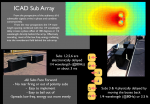Re: First post for me
What I mean is what are the "relationship" between the "sonic impact" that we perceive as a lack of "transient response" in cardiod subwoofer configurations compared to a conventional stack of sub woofers. And how does it show up in the different measurements. Im sure its a myriad of things and yes I'm out of line trying to measure a subjective listing experience, but I think most will agree that some/most cardio subwoofer arrays does sound different (and most seem to think worst) than a "normal" stack of sub woofers. And as we offend defend the design by promoting the benefits of reduced level at the back etc, the disadvantages (if any?) are offend "overlooked". So I guess my question is what designs works and sounds the best, and are we able to see why in the measurements?
All right, it's been a long weekend but as promised here are some subwoofer ruminations.
When delaying and polarity inverting the rear (away from audience) subwoofer to create a cardioid array, the cancellation at the rear is excellent and wide-band because it is accomplished with a polarity inversion. The summation to the front, however, is not perfect because it is accomplished with phase... in a well designed array the frequency of interest will be 360 degrees out of phase out front when coming from the rear subwoofer. With steady state signals this doesn't matter, there is no difference between 360° and 0° as far as they are concerned. However, with dynamic signals (music) the envelope of the waveform is altered, causing this time smearing you can hear. Also, since the addition out front is phase based as you go higher in frequency it slips out of phase and then back in again causing a comb filter like response, this transition is audible just like using a sharper crossover filter would be.
In reality, it is possible to design cardioid subwoofer arrays that sound and perform very well, much better than predictions might show and better than some others might sound. I like to use a very close driver spacing, this keeps the frequency that the array begins combing at out front high and therefore almost entirely out of the subwoofer pass band. I find this still allows for 15+dB of rejection at the rear, how much depends more on the room really. I then gain match and delay at the rear, I find there is usually about a 3dB level difference from the front to the rear, I therefore prefer to use one rear facing sub for two front facing. This means that, with gain matched for "perfect" rejection at the rear, out front the rear subwoofer will be at least 3dB down and often closer to 6dB. It provides SPL contribution still, but as it isn't level matched the time smearing and comb filtering is nowhere near as sharp or significant as it may appear in simulation.
A few years ago, at the second LAB Expo in Massachusetts, a few of us took the time to do some outdoor comparisons of various subwoofer array designs. What we found was that, with three subwoofers, measured a meaningful distance away (let's say 10m or about 30', I forget exactly how far), there was no significant gain difference out front between a three high bottom reversed cardioid array and a three deep very close spacing end fire array. Both were about 3dB less loud than a three high array of all subs facing forward. The biggest difference was at the rear, where the end fire array showed its frequency dependent cancellation. The deepest null was about equivalent to the cardioid array's rear rejection, but the cardioid array did it over its entire usable bandwidth. There was not a significant difference in listening between the two types of directional arrays, with a full range speaker on top. In my experience with many many shows tried both ways there is a small difference, but not anything like people seem to make out or like much more common effects like misaligned tops and subs or crossover phase distortion.
As for large arrays in front of stages, my thoughts are simple. It is a matter of compromises, a sub array as wide as the room, or perhaps 50% wider than the audience outdoors at least, would be ideal. Rarely are we afforded that sort of opportunity. So we must make do with too few subwoofers, regardless of output... or perhaps because of.
The compromise is two fold, evenness of subwoofer coverage, and maintenance of timing information. The former asks for a center cluster, the latter for left/right. However, it is more complicated than that, as with a "smooth coverage" center cluster where it crosses over with the mains now you have three sub arrays, two of them unintentional, ruining both time arrival and coverage. I find with very wide center clusters the time arrival is less of an issue, but as I said we don't have that luxury. So let's go with left/right stacks anyway and make them directional, now we have less energy on stage, we maintain our time coherence, and coverage evenness is somewhere between standard left/right and center cluster because off axis seats mostly see energy from one stack. Additionally, transition from sub array to mains array is less evident since they have the same general lobing. This has become my preferred general method, with at least three deep end fire, it works pretty well plus end fire array lets you get extremely high acoustic output density.


